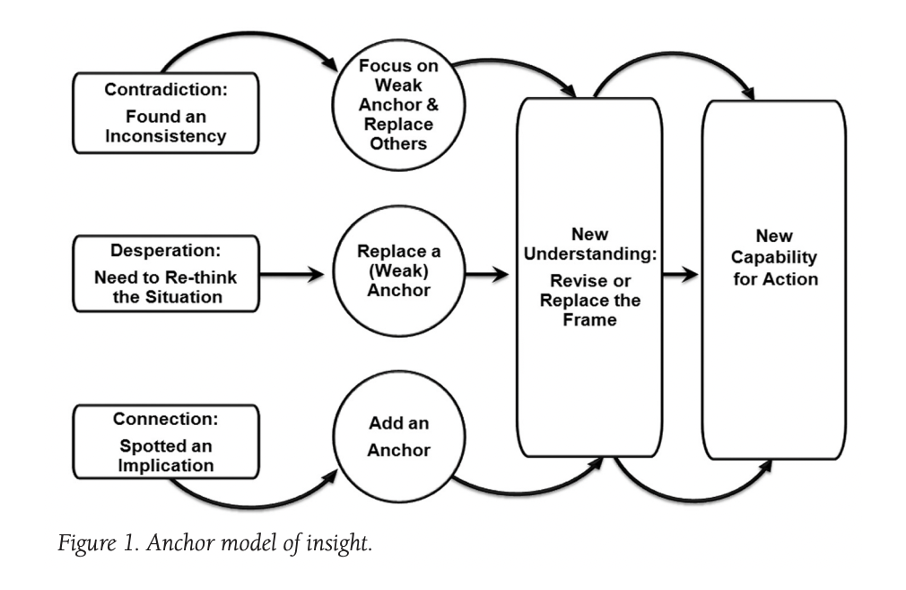The Forgotten Factor: How Insight Adds to the Expertise Equation
Why do so many organizations continue to focus on reducing errors instead of cultivating insights? Our colleague, Micah Condon, discusses the importance of insights and the role insights play in boosting innovation and accelerating expertise.
The Equation for Expertise
Expertise is a focus area for many training and research endeavors – it is often seen as the solution for increasing productivity. Many companies have invested significant time and resources into improving staff expertise through training programs. Yet, even after training, many companies do not see substantial increases in productivity and innovation. Why?
Traditional training modules emphasize memorizing and following established procedures. While this method aims to minimize the number of errors an employee makes – a valuable component of competency – it does not address the entire equation of expertise. Procedures provide a good baseline for routine work but do not allow workers the flexibility to adapt to ambiguous or uncertain situations. Procedural training does not discuss how staff can increase their insights and, therefore, better accelerate their expertise.
Expertise = Reducing Errors + Increasing Insight
– Gary Klein
What do Insights add to Expertise?
Employees must have a working knowledge of standard procedures but should also be open to discovering insights about their environment. While reducing errors promotes consistency, increasing insights fosters growth and creativity. Insights are vital if we want personnel to continue to improve their (tacit) knowledge and problem-solving skills. Yes, it is integral that domain experts are consistent, but they often must also be innovative!

An Insight-State-of-Mind
At a high level, insights are about perception, pattern recognition, causal relationships, and mental models. When looking more practically at how to form insights, we should focus on one key concept: curiosity. Curiosity is the fuel for insight. It propels our engagement and moves us to form questions about the world around us. It helps us identify the key components, or what Gary Klein (2022) calls the three Cs, of making insights.
- Contradictions
- Corrections
- Connections
Note: I will not describe these factors here, but you can check out Gary Klein’s podcast with the Knowledge Project – Insights for Making Better Decisions to learn more.

Are You Curious?
Curiosity feeds into insight through three cardinal traits: active mindset, engagement, and perspective.
An active mindset involves noticing pivotal nuances in the environment and considering their implications. It is about being alert to anomalies and exploring why they exist and what their implications are.
Engagement implies both physical interaction and mental simulation with the environment. Physical interactions, or the “shake the tree” approach (Klein, 2013), can be described as a trial-and-error method, where we perform an action to learn about environmental cause-and-effects. This is not a randomized process but the systematic approach of identifying problems in unsuccessful solutions, and learning how to improve them. Mental simulation describes the process of exploring potential chains of reasoning. These two strategies can help employees stay engaged and explore the possibilities or “what-ifs” of a situation.
Lastly, curiosity builds perspective. A lot of learning requires us to move past fixating on our current beliefs. To do so, we must be able to see beyond them. Other perspectives provide potential answers to inconsistencies within our own beliefs.

Helping Workers Gain Insights
To address the common shortcomings in training, ShadowBox LLC established a new way to promote expertise and insights. Its approach uses curiosity to strengthen cognitive skills like pattern recognition, cue detection, and prioritization. The scenario-based training encourages employees to be more adaptive and confident decision-makers. Additionally, ShadowBox scenarios incorporate uncertainty and complexity – critical factors in many work environments. Instead of promoting strict adherence to procedures, the scenarios equip workers to make better decisions by helping them discover insights about how to handle novel situations. Paired with procedural training, ShadowBox scenario training serves as a more holistic means to bridging the knowledge gap between novice and expert.
Back to the Experts
No matter the domain, experts are insightful. They can recognize patterns, problem-solve, detect fine details, and move past false beliefs. Their curiosity propels them to continuously develop insights and prevents them from becoming stagnant or outdated. To successfully train employees to become experts, we must go beyond memorizing procedures; staff must learn how to find insights. This is the cornerstone of how to think like an expert.
References
Klein, G. A. (2013). Seeing what others don’t: The remarkable ways we gain insights (1st ed.). PublicAffairs Books.
Parrish, S. (Host) (2022, August 9). Gary Klein: Insights For Making Better Decisions (No. 144) [Audio podcast episode]. In The Knowledge Project with Shane Parrish. Farnam Street. https://www.listennotes.com/podcasts/the-knowledge/144-gary-klein-insights-for-tKi3DaqeT_F/